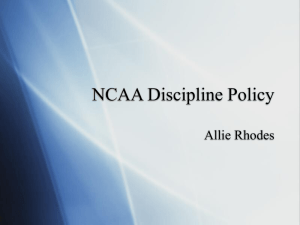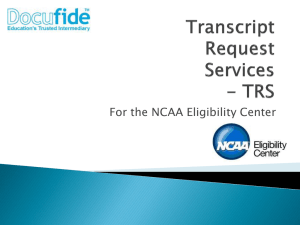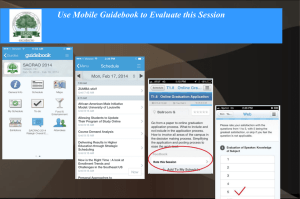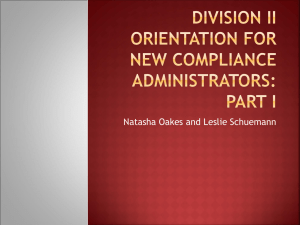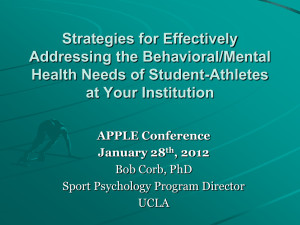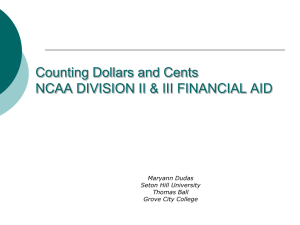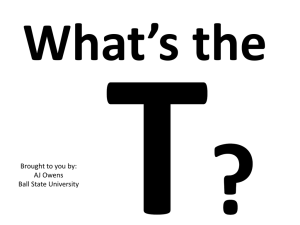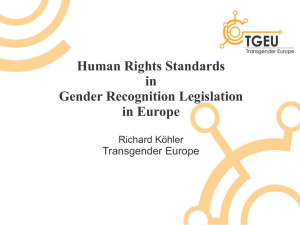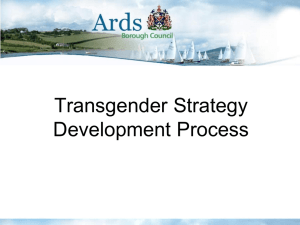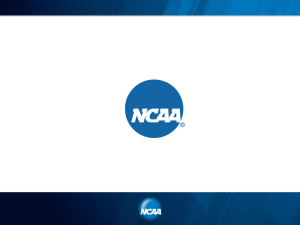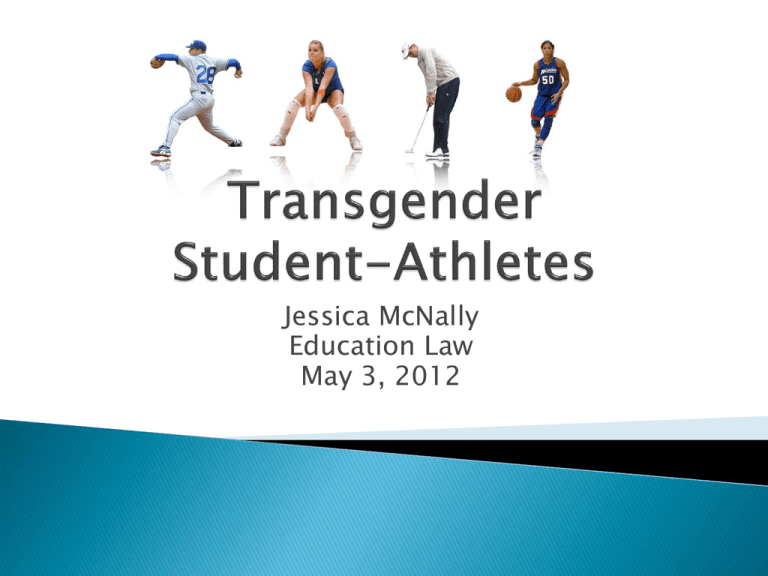
Jessica McNally
Education Law
May 3, 2012
Introduction
Key definitions
Case Study
Current state of the law
Impact on collegiate athletic departments
Current strategies
Additional Issues
Questions
a person whose internal/psychological
gender identity is different from their gender
assigned at birth
◦ Female-to-Male (FTM) transgender: person who is
born in a female body, but identifies as a male.
◦ Male-to-Female (MTF) transgender: person who is
born in a male body, but identifies as a female.
Birth/Assigned Sex- assigned at birth based
on anatomical, physiological, and
chromosomal characteristics.
Gender Identity- person’s internal sense of
being a man or woman.
Gender Expression- socially constructed sets
of behaviors and appearances associated with
being male (masculine) or a female
(feminine).
Transsexual- refers to someone who
transitions from one gender to another
(includes MTF and FTM)
Transitioned- descriptor preferred by some
people who have completed their gender
transition (hormone therapy, counseling, and
surgery)
Gender Non-Conforming- people who are
perceived to have qualities that do not
conform to traditional social expectations.
Sexual Orientation- emotional or sexual
attraction to others based on the gender of
that other person.
International Olympic Committee (IOC)
National Collegiate Athletic Association
(NCAA)
Transgender Student-Athletes (TSA)
United States Tennis Association (USTA)
USTA was in violation of the Human Rights
Law in the state of NY
Richards participated in the US Women’s
Open without submitting to a sex verification
test.
Looked to medical professionals for expertise
on gender verification criteria
◦ Endocrinologist, psychologist, gynecologist
Renee Richards 1977
No federal legislation explicitly prohibits
discrimination based on “gender
identity/expression”
Interpretation of the law
◦ Discrimination, equal protection, and human rights
◦ Some states have specified transgender people in
their anti-discrimination laws
The Employment Non-Discrimination Act
(ENDA)
◦ Bill introduced in 2009 to U.S. Congress
◦ Prohibits public and private employers from using
sexual orientation or gender identity as the basis
for employment decisions
Title IX of the Education Amendments 1972
◦ Successfully used to address discrimination in
schools based on gender stereotypes
Equal Protection Clause of 14th Amendment
◦ Several successful cases involving allegation of
discrimination against LGBT students.
Non-Discrimination Laws
◦ 13 states enacted laws prohibiting discrimination based
on sexual orientation or gender identity/expression
◦ 8 states prohibit discrimination based on sexual
orientation
◦ Additional states have protected transgender people
under disability and medical discrimination laws
Student Rights Laws
◦ 12 states protect student from discrimination based on
sexual orientation OR gender identity
◦ 4 states specifically protect based on sexual identity
What responsibility do Educational Institutions have?
What criteria is appropriate in determining the gender
of a student-athlete?
◦ Athletic departments are responsible to enhance
educational, social, physical, emotional and mental aspects
of all students-athletes through competition
◦ Physical, psychological, hormonal components
How can fair competition be ensured?
How can Institutions avoid litigation?
Where should institutions look for guidance on this
issue?
◦ Gender advantages, performance enhancing drugs
(hormone therapy)
◦ Education, pro-active policy development
◦ NCAA, IOC, Medical and legal expertise, case law
National Collegiate Athletics Association
◦ Governing body for over 1,200 educational
institutions
◦ Institutions are comprised of over 400,000
student-athletes
◦ Oversees 89 Championships in 23 sports
2003: a work group was established to begin to
formulate a position statement and guidance for
membership institutions
2007-2009: an information packet with current
NCAA Position and resources is provided to
member inquiries
2010- NCAA had received 30 distinct inquiries
from membership institutions asking for assistance
with TSA participation
no official policy had been created
Institutions were allowed to make
participation decisions on their own
Rules do not prohibit TSA participation
Gender classification is based on state ID
Championship access rules require males on
female teams to declare “mixed” team status
and render them ineligible for women’s NCAA
championships
Use of medications are subject to NCAA
banned drugs policy and review committees
Hormone therapy may include testosterone
supplementing for FTMs
Testosterone is an NCAA banned substance
George Washington University
◦ Kye Allums
2010- 1st D1 Basketball player to come out
publicly as transgender
Media attention raised social awareness
GW has worked with NCAA and other professionals to
determine eligibility
Kye has decided not to receive hormone therapy or surgery
until after graduation in 2012
2011- Official Policy on TSA participation states:
“a transgender student-athlete may participate in
sex-segregated sports activities so long as the
athlete’s use of hormone therapy is consistent
with the NCAA policies and current medical
standards.”
FTM- must have medical exception for
testosterone and may participate on male team
(no longer eligible for female team)
MTF- must be on testosterone suppressant
therapy for 1 calendar year and may participate
on female team. Regular evaluation of ongoing
therapy documentation required
Educate yourself
◦ Use available resources/collaborate with others
Adopt an effective and fair policy
◦ Be aware of governing bodies policies
◦ Educate coaches, student-athletes, community
Be aware of laws pertaining to nondiscrimination
◦ Include “gender identity/expression” in all official nondiscrimination documentation
Outlined in report “On The Team” by Pat Griffin/Helen Carroll
Building Accommodations
◦ Gender neutral bathrooms/locker rooms
Separate changing areas
Travel/Hotel Accommodations
◦ Separate rooming
◦ Separation vs. Inclusion (grey area)
Dress Code/Apparel Distribution
◦ Traditionally male/female uniforms or formal attire
◦ Equipment manager distribution of appropriate
clothing
“Athletic Organizations who don’t take action
to prepare for the possibility of transgender
or transsexual student-athletes wanting to
compete are going to put themselves in crisis
mode…The smart ones are going to start
investigating what they need to do and what
the implications are, so when it does
happen, they will be in a position to make
good policy.”
-Pat Griffin
Director of Women’s Sports Organization
Over 400 collegiate institutions have policies
prohibiting discrimination based on gender
identity/expression
◦ www.transgenderlaw.org/college/index.htm#policies
UPenn Healthcare Plan inclusion policy up to
$50,000
◦ http://thedp.com/index.php/article/2010/04/u._adds_tran
sgender_insurance
While an NCAA policy is useful in eligibility
and participation, a lot of questions will
remain as to the appropriate daily operations
of administrations, coaches and fellow
student-athletes with regards to TSA
participation
Likely a case-by-case approach will be used
to determine instances of discrimination
suites
Policy development and advocacy for
transgender people is in progress
It Takes a Team!
On The Team: Equal Opportunity for Transgender
Student Athletes
◦ Campaign initiative by WSF
◦ Report generated from national think tank- by Pat Griffin
and Helen Carroll
NCAA Position Statement 2007
Website:
Organizations:
◦ http://www.transgenderlaw.org/college/index.htm#policies
◦
◦
◦
◦
NCLR
WSF
NCAA
OIC

